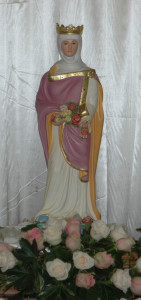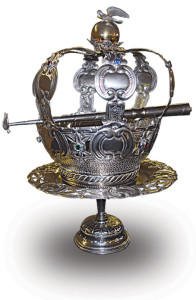Festa do Divino Espirito Santo
(Feast of the Holy Spirit)
 This religious celebration originated with Queen Saint Isabel, daughter of King Aragon, who married a young monarch, Diniz, in Portugal. She was known for her religious devotion, her compassionate heart, and her service to the poor in their time of need.
This religious celebration originated with Queen Saint Isabel, daughter of King Aragon, who married a young monarch, Diniz, in Portugal. She was known for her religious devotion, her compassionate heart, and her service to the poor in their time of need.
Oftentimes, it is said that the Queen saved bread from her own table to give to the hungry. Legend has it that the King tried to stop her from mingling with the poor and was once caught hiding something in her cloak. When he demanded that she open her cloak to show the concealed food, she said a prayer and threw open her cloak, instead of bread, red roses tumbled out. It is for this reason, that the statue of Queen Saint Isabel is depicted with the mantle of flowers.
At one time during Queen Saint Isabel’s reign, there was a terrible famine in Portugal. The Queen depleted all of her funds while seeking food for her people. She had no financial resources left and at Mass, she promised the Holy Spirit, “I will give my crown to the church if you will send me a miracle, so my people will be relieved of the hunger.” After she left the church, she saw ships coming into the harbor loaded with wheat and corn! For 700 years the Portuguese people have celebrated and honored this event in the Festa do Espirito Santo or Feast of the Holy Spirit.
 The Crown, “Coroa”, consists of three individual pieces, the Scepter, Plate, and Crown. The Scepter is accented with a dove, the symbol of the Holy Spirit whose love was so manifested in Queen Saint Isabel’s life. The Plate serves as a stand for the Crown and represents the people. The Crown has a double significance… first, it represents the supreme dominion of the Holy Spirit, and secondly the royalty of the Queen.
The Crown, “Coroa”, consists of three individual pieces, the Scepter, Plate, and Crown. The Scepter is accented with a dove, the symbol of the Holy Spirit whose love was so manifested in Queen Saint Isabel’s life. The Plate serves as a stand for the Crown and represents the people. The Crown has a double significance… first, it represents the supreme dominion of the Holy Spirit, and secondly the royalty of the Queen.
